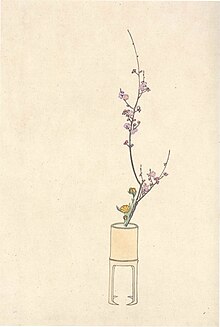
Back إيكيبانا Arabic ইকেবানা Assamese İkebana Azerbaijani ایکبانا AZB Ikebana BCL Ікебана Byelorussian Икебана Bulgarian Ikebana Catalan Ikebana Czech Ikebana German
This article has multiple issues. Please help improve it or discuss these issues on the talk page. (Learn how and when to remove these template messages)
|


Ikebana (生け花, 活け花, 'arranging flowers' or 'making flowers alive') is the Japanese art of flower arrangement.[1][2] It is also known as kadō (華道, 'way of flowers'). The origin of ikebana can be traced back to the ancient Japanese custom of erecting evergreen trees and decorating them with flowers as yorishiro (依代 )to invite the gods.
Later, flower arrangements were instead used to adorn the tokonoma (alcove) of a traditional Japanese home.
Ikebana is counted as one of the three classical Japanese arts of refinement, along with kōdō for incense appreciation and chadō for tea and the tea ceremony.
- ^ "Ikebana International". www.ikebanahq.org. Archived from the original on 12 July 2014.
- ^ "Definition of IKEBANA". www.merriam-webster.com. Archived from the original on 9 October 2017.
© MMXXIII Rich X Search. We shall prevail. All rights reserved. Rich X Search